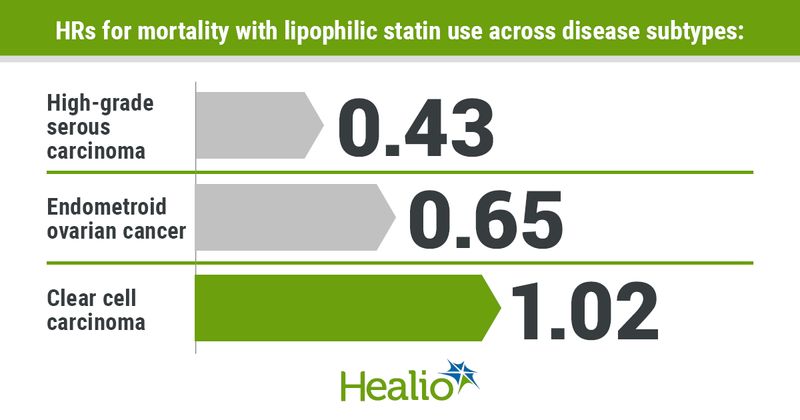Lipophilic statin use associated with reduced ovarian cancer mortality
Lipophilic statins appeared associated with reduced mortality among women with ovarian cancer, according to results of a retrospective study presented at American Association for Cancer Research Virtual Annual Meeting II.
These statins should be tested in a randomized clinical trial as a treatment for ovarian cancer, researchers noted.

“The 5-year survival rate of ovarian cancer in the United States and other developed countries remains under 50%,” Kala Visvanathan, MD, MHS, professor of epidemiology and oncology at Johns Hopkins Bloomberg School of Public Health and Sidney Kimmel Comprehensive Cancer Center, said during a presentation. “There are no proven screening strategies, and there is an urgent need to find cheaper, effective treatment alternatives given the worldwide increase in incidence.”
About 28% of adults aged 40 years and older in the United States take statins regularly as a cholesterol medication.
Previous studies evaluating statins as treatment for ovarian cancer have shown mixed results. However, encouraging preclinical and epidemiologic data, as well as the broad access, low cost and modest toxicity of statins, makes the concept of repurposing these drugs appealing.
Visvanathan and colleagues analyzed data from 10,062 Finnish women (median age, 63 years; interquartile range [IQR], 53-74) diagnosed with ovarian cancer between 1995 and 2015 to identify potential associations between pre- and post-diagnostic use of statins and mortality.
Researchers adjusted analyses based on age at diagnosis, stage, disease subtype, treatments, year of diagnosis and chronic disease medications.
Median follow-up was 4 years (IQR, 1.5-9.3).
About one-quarter of the women (n = 2,621) used statins, and 80% of those women took statins classified as lipophilic. Median duration of statin use was 7.5 years (IQR, 3.6-11.4), and 82% of statin users filled 90% of their prescriptions.
Results showed ever-use of statins reduced ovarian cancer mortality by 40% compared with never-use of statins (HR = 0.6; 95% CI, 0.57-0.63). Researchers reported an HR for lipophilic statin use of 0.78 (95% CI, 0.64-0.83).
Women treated with curative intent derived a larger benefit from statin use than women treated with palliative intent (HR = 0.19 vs. 0.41).
Researchers also observed reductions in ovarian cancer mortality among women who primarily took one lipophilic statin, including atorvastatin (HR = 0.35; 95% CI, 0.22-0.5) and simvastatin (HR = 0.25; 95% CI, 0.22-0.34).
Among women taking lipophilic statins, researchers observed a greater reduction in mortality with increased statin dose (P = .06).
Although lipophilic statin use also appeared associated with a reduction in ovarian cancer mortality among most disease subtypes, the degree of reduction varied. Those with high-grade serous carcinoma (HR = 0.43; 95% CI, 0.33-0.76), endometroid ovarian cancer (HR = 0.65; 95% CI, 0.34-0.78) and borderline disease (HR = 0.3; 95% CI, 0.25-0.87) demonstrated the greatest reductions compared with women with mucinous (HR = 0.6; 95% CI, 0.45-0.95) and clear cell carcinoma (HR = 1.02; 95% CI, 0.98-1.98).
Women who started taking lipophilic statins after diagnosis also demonstrated reductions in ovarian cancer mortality.

“Our results support further evaluation of lipophilic statins in women with epithelial ovarian cancer in a randomized controlled trial in conjunction with existing therapies,” Visvanathan said. “Our results also reinforce examining existing therapies that are well-tolerated and inexpensive to help decrease the global cancer burden.”









